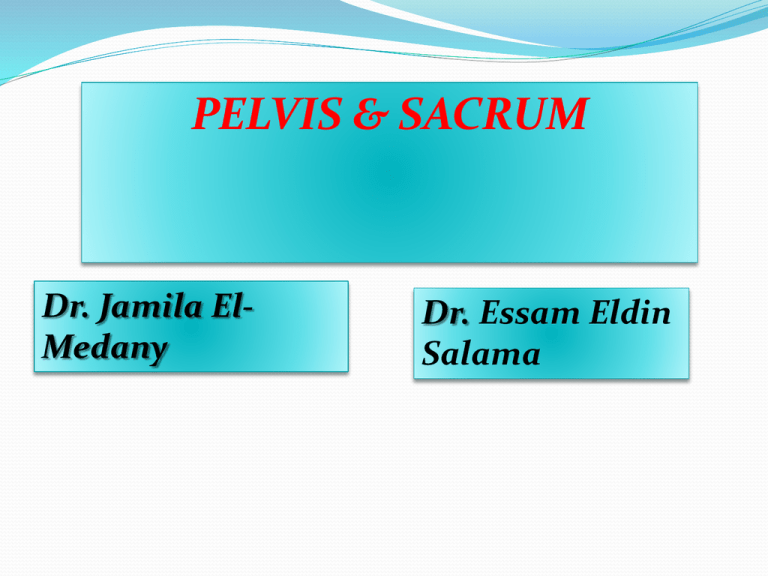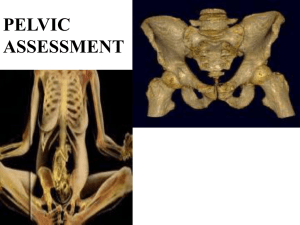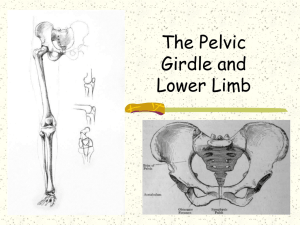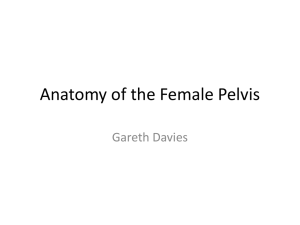Sacrum and pelvis
advertisement

PELVIS & SACRUM Dr. Jamila ElMedany Dr. Essam Eldin Salama Learning Objectives At the end of the lecture, the students should be able to : Describe the bony structures of the pelvis. Describe in detail the hip bone, the sacrum, and the coccyx. Describe the boundaries of the pelvic inlet and outlet. Identify the structures forming the pelvic walls. Identify the articulations of the bony pelvis. List the major differences between the male and female pelvis. List the different types of female pelvis. BONY PELVIS It is composed of (4) Bones: Two Hip Bones. Sacrum. Coccyx. Its Main Functions are: Transmits the weight of the body from the vertebral column to the femurs. (The total weight of the upper body rests on the pelvis). Contains, supports and protects the pelvic viscera. Provides attachment to trunk and lower limb muscles. Pelvic Girdle Its bones are large & heavy. Bearing weight is their most important function. It is composed of Two Hip Bones. Hip Bone It is a large irregular bone. formed by the fusion of three boness: Ilium Ischium Pubis. They are joined at the deep socket (Acetabulum) Ilium The Upper Flattened Part of the hip bone. It Possesses: Iliac Crest : an important anatomical landmark below the waist. It runs between the Anterior and Posterior Superior Iliac Spines. Below are the corresponding Anterior and Posterior Inferior Iliac Spines. The outer surface is rough and has gluteal lines. On the inner surface: Iliac Fossa (forms false pelvis) Auricular surface( for articulation with the sacrum). Iliopectinial Line: runs Downwards & Forwards (separates between the False & the True pelvis) . Pubis Forms the Anterior & inferior part. Has : Body; bears the Pubic Crest and Pubic Tubercle. Two pubic Rami: Superior & Inferior, bounding the Obturator Foramen (for passage of blood vessels & nerves into the anterior part of the thigh) it is closed partially by the obturator membrane. Ischium Forms the Inferior and Posterior part. It has: Ischial Tuberosity: A roughened area that receives body weight in sitting. Ischial Spine: Superior to the tuberosity, it is important especially in pregnant women. Greater sciatic notch: Allows sciatic nerve & vessels to pass from pelvis to thigh. Lesser sciatic notch: allow vessels & nerves to pass from pelvis to perineum. Articulations of Hip Bone 1. Symphysis Pubis: A Cartilagenous joint between the two pubic bones (2) Sacroiliac Joints Strong synovial joints, between the auricular surfaces of Ilium and sacrum. Transmit the weight of the body from vertebral column to the bony pelvis. (3) Hip Joint: The outer surface articulates at the acetabulum with the head of femur Fractures of the Pelvis The weakest parts of the pelvis are: Pubic rami. Acetabula. Region of sacroiliac joint. Alae of the ilium. Pelvic Fractures can result from direct trauma to the pelvic bones as occurs in car accidents or by forces transmitted to these bones from the lower limbs during falls on the feet. They across the weak part of the pelvis. Pelvic fractures may cause injury to the pelvic soft tissues, blood vessels, nerves and organs. Sacrum A Single Wedge shaped bone (consists of Five rudimentary vertebrae fused together) Sacral Promontory: The anterior and upper margin It is tilted forward forming the lumbosacral angle. The anterior and posterior surfaces possess on each side (4 ) Sacral Foramina. The fused vertebral foramina form the Sacral Canal. Its lower limit is the Sacral Hiatus . Coccyx Consists of (4) vertebrae fused together forming a single Triangular piece Articulations of Sacrum Lumbsacral joint: The upper border articulates with the 5th Lumber vertebra Sacrococcygeal joint: The inferior part articulates with the Coccyx Sacroiliac joints: Lateral with the Hip bones. Orientation of the Pelvis It is the Correct Position of the bony pelvis relative to the trunk (in the anatomical position): 1.The front of the Symphysis pubis and the Anterior Superior iliac spines lie in the same vertical plane. 2. The pelvic surface of the Symphysis pubis faces upward and backward. 3.The anterior surface of the Sacrum is directed forward and downward. Subdivisions of the Pelvis It is divided by the Pelvic Brim (Pelvic Inlet) into: True pelvis. False pelvis. False pelvis Lies superior to the pelvic brim. Enclosed by the Fossae of the iliac bones Forms the inferior region of the abdominal cavity. Houses the Inferior abdominal organs True Pelvis Lies inferior to the pelvic brim. Encloses the pelvic cavity. Contains the pelvic organs. It has : Inlet Outlet. Pelvic walls Pelvic Inlet (pelvic Brim) Bounded by: Sacral promontory Iliopectineal lines. Symphysis pubis. Pelvic Outlet Bounded by: Coccyx Ischial tuberosities. Pubic arches. Bones of Pelvic Walls Anterior Wall : Posterior surfaces of bodies of pubic bones. Pubic rami. Symphysis pubis. Posterior Wall : Sacrum and Coccyx Lateral Pelvic Wall: Hip bone below the pelvic inlet. SEX DIFFERENCES Bony pelvis Male Female General structure Thick & Heavy Thin & Light False (major) pelvis Deep Shallow True (lesser) pelvis Narrow & Deep Wide & Shallow Pelvic Inlet Heart shaped Oval or Rounded Pelvic Outlet Small Large Pubic Arch Narrow & Subpubic angle Wide Obturator foramen Round Oval Acetabulu m Large Small Sacrum F M Length Longer Breadth Narrower Curvature Shorter Wider Less Curved Forensic Medicine & BonyPelvis Female Pelvic Inlet Pelvic Outlet Pelvic Cavity Pubic Arch Male For identification of human skeletal remains, the bony pelvis is of prime focus of attention because sexual differences are clearly visible. Even parts of the pelvis are useful in making a diagnosis of sex. Types of Obstetrical Female Pelvis (1) Gynaecoid: normal female type (2) Anthropoid. (3) Android : common in males. (if found in a woman, it causes hazards to normal vaginal delivery) (4) Platypelloi; uncommon in both sexes (2) (3) (1) (4) Thank you









